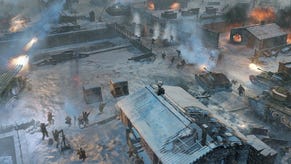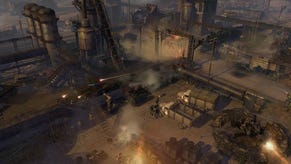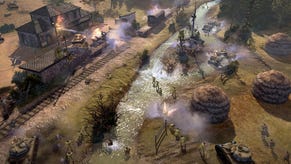Hands On: Company Of Heroes 2
The cold soldier
At Gamescom, Relic gave me an article of clothing that says "I survived the Eastern Front" across the back in striking red letters. Considering I barely survived a stroll down the Brighton sea front a couple of months back because there was a bit of rain, it seems inappropriate for me to wear such a statement. I also lost to the AI during a skirmish game of Company of Heroes 2, my blood become ice, but that's because I wasn't really trying to win. Here's what I was doing instead.
I'm not saying that I would have won or could have won. My Company of Heroes' skills were rustier than the blasted turret of a long-unmanned T-34, so as well as trying to direct some of my brain cells toward the problem of dealing with the hazardous blizzards swarming across the battlefield, I spent the first ten minutes struggling to remember the basics. It's not a complex game, just as the original wasn't, but as with anything that occurs in realtime, there are rhythms and procedures that the mind and hands naturally fall into. Before that synchrony is discovered, nothing is quite as simple as it seems.
During the tutorial mission, before the skirmish, my soviet conscripts learned how to vault over cover, or at least I learned how to tell them to vault over cover. It's sensible that they've been taught how to vault at boot camp, which as I understand it, in this time and place, was an actual place where soldiers were given a boot and then told to go and fight until the cold or the climate killed them. Vaulting means that they can cower in their boot behind cover and can also propel themselves over that cover to relocate quickly if flanked, or to move forward if they are fortunate enough to fell their enemies.
In practice, it is now easier to adapt to the space of a map and this doesn't just help with tactical positioning, it also plays into the new line of sight system, which already seems like the sequel's most important feature. The fancy graphics and weather systems (more of which later) are the elements that assault the ocular terrain, but it's TrueSight that actually cares about your eyes and the eyes of your troops. At first, I barely noticed that anything was different, except for the crunch of snow underfoot and the thermometer icons that appeared next to my troops whenever the wind and ice whipped up like a storm of razors. This really does seem to be more of the same, which is exactly what I thought I wanted, though I must admit there was a slight sense of anticlimax when I realised how little had changed. Aside from the realisation of character and place, I find the steady, thoughtful pace of Company of Heroes to be its most appealing aspect.
Look at a map, exquisitely detailed and evocative as they are, and eventually it becomes lines of cover, soft and hard, directions of attack, pivots on which to place machine guns and mortars, wider tracks down which death may trundle in the shape of a tank. Once units have been moved into position on this abstract overlay, it's as if the game falls into a strange, almost turn-based and unreal mode of time, where bullets are cutting through the air but a strange serenity steps between them, calculating and countering.
Turns aren't handed out in this disjointed timespace though, they must be seized. It seems, from the lower segment of the sky where commanders hover, that soldiers can remain in their cover forever, but as soon as the enemy moves, or decides to lob an explosive, time flows once more. The stalemate is broken. A good commander will move fast, or perhaps have his reactions prepared, ready to act as soon as the enemy shows his hand. That's how Company of Heroes seems to me; movement and death punctuated by pauses that are not pauses. There's room to think and to plan, which I appreciate.
When moving to new cover or flanking an enemy unit can cause them to be obscured from view, the careful process of move-plan-move can become more fraught than used to be the case. It's no longer a given that the enemy location will be known once discovered, with buildings, trees and smoke all serving to block line of sight. The brilliant peril of it all first became evident to me when a unit of riflemen were running through some woods, attempting to take up position at the rear of a bedded-in German machinegun. The snowscape around the trees strobed in and out of view, the trunks obscuring whatever was behind them at any one moment. Weird. Unsettling. And then, through one gap, revealed for a second, maybe less, something large and metal. Now that we'd glimpsed it the noise of its engine seemed obvious, stuttering through the white noise of the blizzard.
It had seen us too. The trees shook, trembled and split as the thing toppled them, bursting into view, opening up our view in fact as it destroyed the surroundings. They weren't soldiers anymore, my men, they were prey.
So, rather than winning, the first thing I did after being blindly stalked by a tank was to run around in the woods marvelling at the way my line of sight fractured and cohered. I threw grenades at everything that looked like it might fall to bits (everything), not just so that I could write down 'things explode convincingly' in my notebook, but so I could see how each soldier's line of sight was altered by the changes to the scenery. It's impressive and works down to a level that's probably too intricate and small in scale to make a real difference, but that's the nature of fully simulating a feature. It often goes deeper than it needs to and unless that causes a massive hit to performance, there's nothing wrong with that.
As for the weather, I played with that too, although not as I expected to. Fires are essential to survival in the horrendous conditions and engineers can build them anywhere. An infantry unit caught in a blizzard, which sweep through seemingly at random, will slow down and eventually die if they don't find cover and warmth. Engineers are lifesavers, then, and they're also obvious targets because taking them out is akin to cutting a major supply line, the supply being heat and life. Two play sessions on two maps didn't really provide enough time to form an opinion as to whether the cold will make conflict more interesting. I worry that it might be one action too many, requiring the player to check on troops and assist them as if they are sporadically bursting into flame. Having to extinguish them occasionally, maybe constructing a sprinkler system for future use, would have much the same effect, although admittedly the cold isn't quite so quick to kill as flame would be.
But, no, freezing men didn't entertain me for long. Frozen water did and this is why I lost. In the centre of the skirmish map there was a river, now an ice rink, and occasionally tanks would attempt to cross that river. I'd watch them as they skidded, the physics genuinely impressive and entertaining, so much so that I can't help but assume they are massively exaggerated. It's quite hypnotic, like seeing a professional wrestler trying to figure skate. And then blowing up the ice and watching them drown. I must have sent so many tanks to the riverbed that they should really have started piling on top of one another and protruding like a horrific amphibious sculpture. I failed because I was more interested in playing with the ice and the line of sight rather than seizing objectives, and that was a satisfying way to spend an hour.
Company of Heroes 2, then, is Company of Heroes but with modernised visuals, weather and tanks falling through holes in ice. But most importantly, it's an RTS that still favours the thinker over the clicker and that has, in TrueSight, a technical addition that is neither bell nor whistle. It also has sound design that makes me want to buy a new set of speakers. The drone of a plane and the punch of explosions has never sounded quite so much like strange, industrial music.











